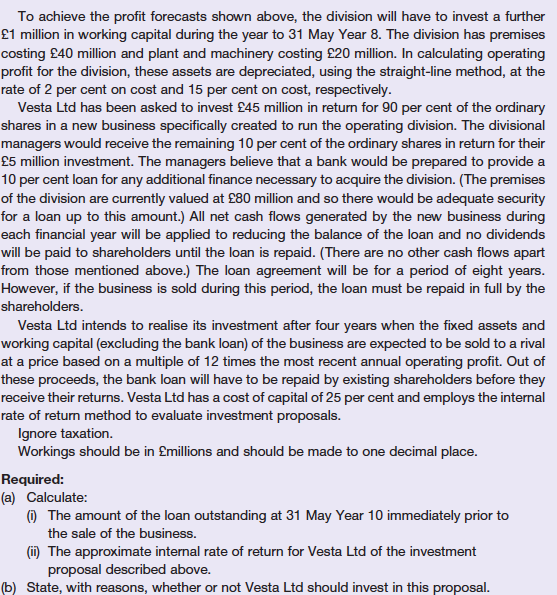
To achieve the profit forecasts shown above, the division will have to invest a further 1 million in working capital during the year to 31 May Year 8. The division has premises costing 40 million and plant and machinery costing 20 million. In calculating operating profit for the division, these assets are depreciated, using the straight-line method, at the rate of 2 per cent on cost and 15 per cent on cost, respectively. Vesta Ltd has been asked to invest 45 million in return for 90 per cent of the ordinary shares in a new business specifically created to run the operating division. The divisional managers would receive the remaining 10 per cent of the ordinary shares in return for their 5 million investment. The managers believe that a bank would be prepared to provide a 10 per cent loan for any additional finance necessary to acquire the division. (The premises of the division are currently valued at 80 million and so there would be adequate security for a loan up to this amount.) All net cash flows generated by the new business during each financial year will be applied to reducing the balance of the loan and no dividends will be paid to shareholders until the loan is repaid. (There are no other cash flows apart from those mentioned above.) The loan agreement will be for a period of eight years. However, if the business is sold during this period, the loan must be repaid in full by the shareholders. Vesta Ltd intends to realise its investment after four years when the fixed assets and working capital (excluding the bank loan) of the business are expected to be sold to a rival at a price based on a multiple of 12 times the most recent annual operating profit. Out of these proceeds, the bank loan will have to be repaid by existing shareholders before they receive their returns. Vesta Ltd has a cost of capital of 25 per cent and employs the internal rate of return method to evaluate investment proposals. Ignore taxation. Workings should be in millions and should be made to one decimal place. Required: (a) Calculate: The amount of the loan outstanding at 31 May Year 10 immediately prior to the sale of the business. (m) The approximate internal rate of return for Vesta Ltd of the investment proposal described above. (b) State, with reasons, whether or not Vesta Ltd should invest in this proposal. To achieve the profit forecasts shown above, the division will have to invest a further 1 million in working capital during the year to 31 May Year 8. The division has premises costing 40 million and plant and machinery costing 20 million. In calculating operating profit for the division, these assets are depreciated, using the straight-line method, at the rate of 2 per cent on cost and 15 per cent on cost, respectively. Vesta Ltd has been asked to invest 45 million in return for 90 per cent of the ordinary shares in a new business specifically created to run the operating division. The divisional managers would receive the remaining 10 per cent of the ordinary shares in return for their 5 million investment. The managers believe that a bank would be prepared to provide a 10 per cent loan for any additional finance necessary to acquire the division. (The premises of the division are currently valued at 80 million and so there would be adequate security for a loan up to this amount.) All net cash flows generated by the new business during each financial year will be applied to reducing the balance of the loan and no dividends will be paid to shareholders until the loan is repaid. (There are no other cash flows apart from those mentioned above.) The loan agreement will be for a period of eight years. However, if the business is sold during this period, the loan must be repaid in full by the shareholders. Vesta Ltd intends to realise its investment after four years when the fixed assets and working capital (excluding the bank loan) of the business are expected to be sold to a rival at a price based on a multiple of 12 times the most recent annual operating profit. Out of these proceeds, the bank loan will have to be repaid by existing shareholders before they receive their returns. Vesta Ltd has a cost of capital of 25 per cent and employs the internal rate of return method to evaluate investment proposals. Ignore taxation. Workings should be in millions and should be made to one decimal place. Required: (a) Calculate: The amount of the loan outstanding at 31 May Year 10 immediately prior to the sale of the business. (m) The approximate internal rate of return for Vesta Ltd of the investment proposal described above. (b) State, with reasons, whether or not Vesta Ltd should invest in this proposal







